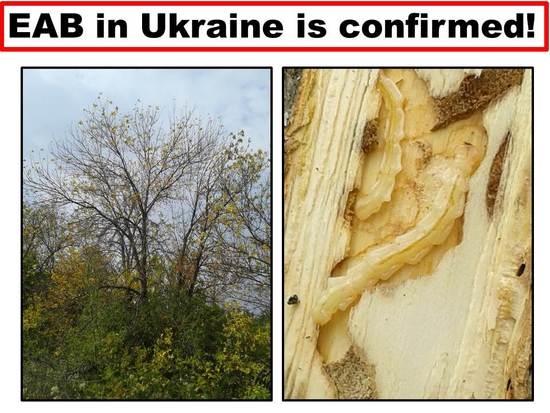Record of the Emerald Ash Borer (Agrilus planipennis) in Ukraine is Confirmed
Abstract
:1. Introduction
2. Materials and Methods
3. Results
4. Discussion
5. Conclusions
Author Contributions
Funding
Conflicts of Interest
References
- Orlova-Bienkowskaja, M.J.; Volkovitsh, M.G. Are native ranges of the most destructive invasive pests well known? A case study of the native range of the emerald ash borer, Agrilus planipennis (Coleoptera: Buprestidae). Biol. Invasions 2018, 20, 1275–1286. [Google Scholar] [CrossRef]
- Emerald Ash Borer Info. Available online: http://www.emeraldashborer.info/ (accessed on 7 September 2019).
- Straw, N.A.; Williams, D.T.; Kulinich, O.A.; Gninenko, Y.I. Distribution, impact and rate of spread of emerald ash borer Agrilus planipennis (Coleoptera: Buprestidae) in the Moscow region of Russia. Forestry 2013, 86, 515–522. [Google Scholar] [CrossRef]
- Orlova-Bienkowskaja, M.J. Ashes in Europe are in danger: The invasive range of Agrilus planipennis in European Russia is expanding. Biol. Invasions 2014, 16, 1345–1349. [Google Scholar] [CrossRef]
- Valenta, V.; Moser, D.; Kapeller, S.; Essl, F. A new forest pest in Europe: A review of Emerald ash borer (Agrilus planipennis) invasion. J. Appl. Entomol. 2017, 141, 507–526. [Google Scholar] [CrossRef]
- Baranchikov, Y.N.; Demidko, D.A.; Seraya, L.G. A quarter-century of emerald ash borer in Europe. In Proceedings of the Conference Preparing Europe for Invasion by the Beetles Emerald Ash Borer and Bronze Birch Borer, Two Major Tree-Killing, Vienna, Austria, 1–4 October 2018; Mayer, P., Ed.; BFW: Vienna, Austria, 2018; p. 9. [Google Scholar]
- Orlova-Bienkowskaja, M.J.; Drogvalenko, A.N.; Zabaluev, I.A.; Sazhnev, A.S.; Peregudova, E.Y.; Mazurov, S.G.; Komarov, E.V.; Bienkowski, A.O. Bad and good news for ash trees in Europe: Alien pest Agrilus planipennis has spread to the Ukraine and the south of European Russia, but does not kill Fraxinus excelsior in the forests. bioRxiv 2019, 689240. [Google Scholar] [CrossRef]
- EPPO Global Database. Agrilus planipennis Does Not Occur in Ukraine. EPPO Reporting Service (2019/156). Available online: https://gd.eppo.int/reporting/article-6586 (accessed on 7 September 2019).
- Volkovitsh, M.G.; Orlova-Bienkowskaja, M.J.; Kovalev, A.V.; Bieńkowski, A.O. An illustrated guide to distinguish emerald ash borer (Agrilus planipennis) from its congeners in Europe. Forestry 2019. [Google Scholar] [CrossRef]
- Rosselkhoznadzor (2019) Russian Federal Service for Veterinary and Phytosanitary Surveillance. Open Data Russia. Available online: https://data.gov.ru/opendata/7708523530-carantinzone (accessed on 26 June 2019).

© 2019 by the authors. Licensee MDPI, Basel, Switzerland. This article is an open access article distributed under the terms and conditions of the Creative Commons Attribution (CC BY) license (http://creativecommons.org/licenses/by/4.0/).
Share and Cite
Drogvalenko, A.N.; Orlova-Bienkowskaja, M.J.; Bieńkowski, A.O. Record of the Emerald Ash Borer (Agrilus planipennis) in Ukraine is Confirmed. Insects 2019, 10, 338. https://doi.org/10.3390/insects10100338
Drogvalenko AN, Orlova-Bienkowskaja MJ, Bieńkowski AO. Record of the Emerald Ash Borer (Agrilus planipennis) in Ukraine is Confirmed. Insects. 2019; 10(10):338. https://doi.org/10.3390/insects10100338
Chicago/Turabian StyleDrogvalenko, Alexander N., Marina J. Orlova-Bienkowskaja, and Andrzej O. Bieńkowski. 2019. "Record of the Emerald Ash Borer (Agrilus planipennis) in Ukraine is Confirmed" Insects 10, no. 10: 338. https://doi.org/10.3390/insects10100338




